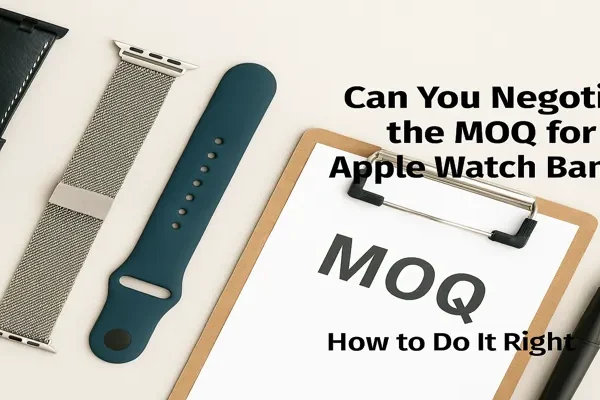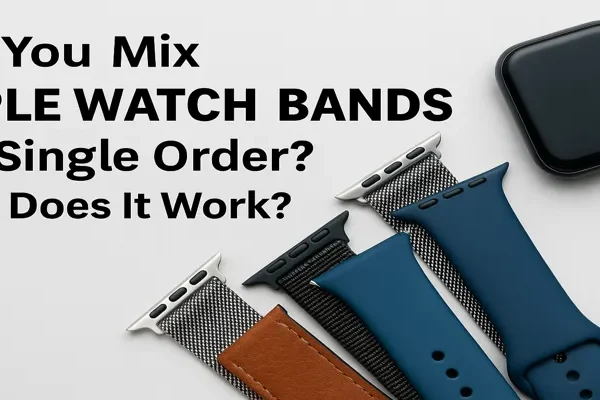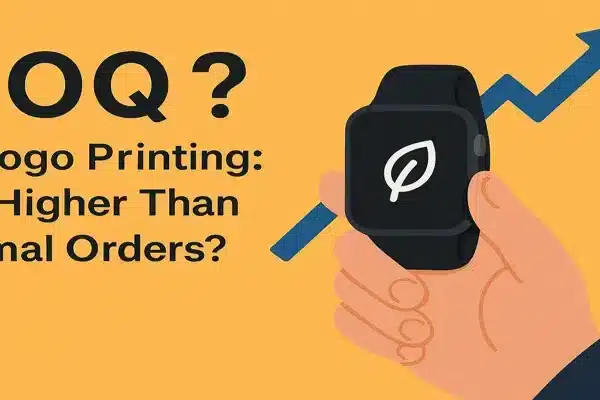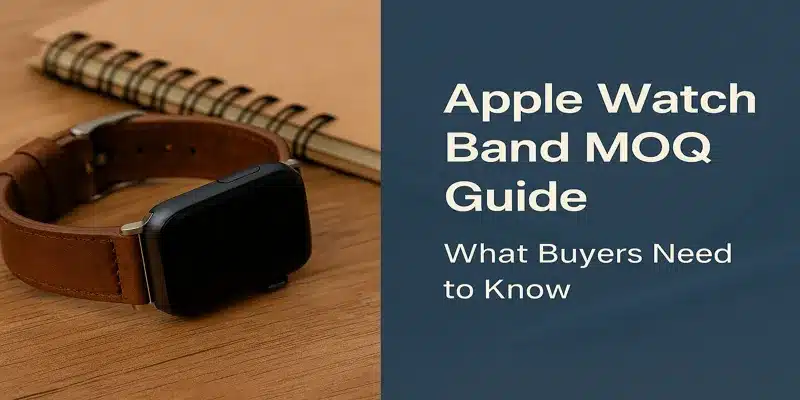
Introduction: Understanding MOQ in the Apple Watch Band Industry
The Apple Watch band market has exploded in recent years, creating exciting opportunities for brands and entrepreneurs around the world. But for many small businesses and startups, there’s a frustrating obstacle that comes up again and again: MOQ (Minimum Order Quantity).
It feels like a gatekeeper, locking you out before you even get started. You want to test a new design, try a custom logo, or simply order a small batch—but suppliers insist on 300, 500, or even 1,000 units. Why is that? And more importantly, is there any way to make MOQ work for your business without taking on unnecessary risk?
As a supplier deeply involved in Apple Watch band manufacturing, we understand how challenging this can be. That’s why we created this guide—not just to explain what MOQ is, but to help buyers (especially startups and small businesses) understand the realities behind MOQ, and more importantly, how to navigate those realities to build successful, long-term partnerships with suppliers.
In this guide, we’ll cover:
- Why MOQ exists and why it matters
- What makes Apple Watch band MOQs unique in this industry
- The challenges high MOQs create for small buyers
- Practical strategies for negotiating and working with suppliers
- And how you can turn MOQ from a roadblock into a smart business tool
Let’s start by breaking down the basics: What is MOQ, really?

✦ 01| What Is MOQ? Why Does It Matter?
MOQ stands for Minimum Order Quantity—the smallest number of units a supplier is willing to produce or sell in a single order. At its core, MOQ is not just a number, but a reflection of how factories manage their costs, resources, and risks.
From a supplier’s perspective, here’s why MOQ exists:
01 Economies of Scale
Factories rely on volume to keep unit costs low. Producing 1,000 Apple Watch bands costs far less per unit than producing just 100 because the setup costs—like machine calibration, material preparation, and labor allocation—are spread across a larger batch.
02 Production Efficiency
Small orders disrupt production lines. Every time a factory switches to a new product or design, machines must be cleaned, settings adjusted, and materials swapped out. Frequent small orders increase downtime, lower efficiency, and raise costs.
03 Material Procurement
Suppliers often need to purchase raw materials in bulk themselves. For example, a specific type of leather or custom silicone might only be available in minimum lots of 500–1,000 units from upstream vendors. A small order of 50 units can’t justify this bulk buy.
04 Operating Cost Recovery
Every order requires staff time for processing, quality checks, packaging, shipping, and customer support. MOQ helps cover these fixed costs and ensures the supplier isn’t losing money on small, fragmented orders.
05 Sustainable Profit Margins
Let’s be honest: small orders are often not profitable for suppliers. They involve the same or even more work per unit than larger orders but generate less total revenue. MOQ helps ensure the factory stays in business while providing reliable service.
👉 In short, MOQ is not an arbitrary rule or a way to make life harder for small buyers. It’s a survival mechanism for factories in a highly competitive, low-margin industry.
By understanding this, you can start to see MOQ not as a barrier, but as a negotiation point—and that’s exactly what we’ll explore next.
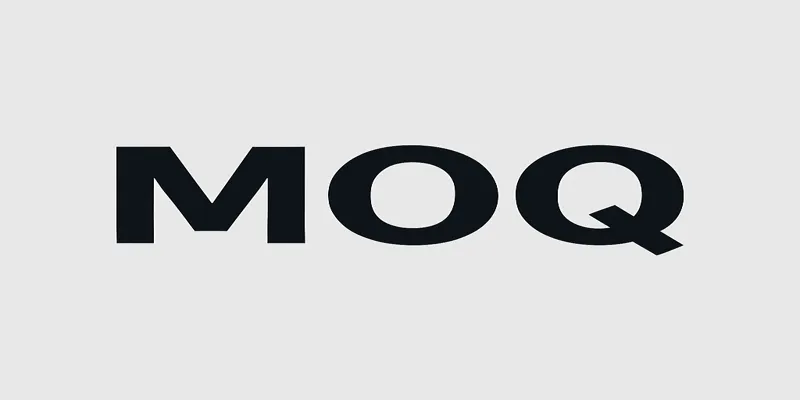
✦ 02| Apple Watch Band MOQs: Why Are They So Complicated?
Now that you understand what MOQ is and why suppliers need it, let’s zoom in on the Apple Watch band industry—because not all MOQs are created equal.
Apple Watch bands might seem like simple products, but the reality is far more complex. Here’s why MOQ in this industry often feels higher—and harder to navigate—than in other product categories.
1. Intense Competition + Differentiation Pressure
The Apple Watch band market is crowded. From big brands to small niche sellers, everyone’s competing for attention. This leads suppliers to offer a wide variety of options—different materials, designs, colors, sizes, and customizations.
But here’s the catch: more choices = more SKUs = higher MOQ. Every variation—whether it’s a different color or a slightly different buckle—needs to be produced, stocked, and managed separately. This is why a simple request like “I want to order 50 bands in 5 colors” often gets pushback from suppliers: each color is treated as a separate SKU, each with its own MOQ requirements.
2. Materials and Craftsmanship Impact MOQ
Let’s talk about materials—because not all Apple Watch bands are created equal:
| Material | Typical MOQ | Why? |
|---|---|---|
| Silicone | 100–200 units | Mass production, simple molds, lower risk |
| Nylon | 200–300 units | Requires specialized weaving, colorfastness checks |
| Leather | 300–500 units | Handwork, natural material variation, QC-intensive |
| Metal (stainless steel, titanium) | 300–500 units | Complex machining, polishing, plating processes |
For example: a leather band isn’t just a strip of leather. It involves cutting, stitching, edge painting, and sometimes embossing—all of which add labor and increase risk. Suppliers need higher MOQs to justify the setup time and material waste that comes with these processes.
Curious about how materials impact MOQ? Check out our in-depth guide: How Different Materials Affect Apple Watch Band MOQ.
3. Customization Requests Raise the Bar
Want to add a logo? Custom color? Unique packaging? Every layer of customization increases complexity and risk. For suppliers, customization often means:
- Creating new molds or printing plates
- Adjusting production schedules
- Setting up separate quality control standards
- Managing small-batch inventory (which ties up cash flow)
That’s why a factory may say: “MOQ for standard bands is 200 units, but for custom logo bands, it’s 500.”
For a deeper dive into this topic, check out: MOQ for Logo Printing: Is It Higher Than Standard Orders? Watch Band Packaging Custom Guide
4. Compliance and Certification Considerations
For certain markets—like the EU or US—suppliers must meet specific safety and environmental standards (like RoHS, REACH, or CA Prop 65). Testing and certification costs aren’t spread across a single unit; they apply to the entire batch.
👉 If you want certified materials or compliance guarantees, expect the MOQ to reflect those additional costs.
5. Seasonality and Demand Fluctuations
MOQ isn’t static. During peak seasons—like before holidays—factories prioritize large-volume orders. Smaller buyers may find themselves pushed down the queue or offered higher MOQs because production capacity is limited.
During off-peak times, however, you might have more room to negotiate. Understanding these cycles can help you plan orders more effectively.
Final Thought for This Section
The Apple Watch band industry is a mix of mass production and bespoke craftsmanship. Every design, material, and customization option adds layers of complexity—and that’s why MOQ can feel higher than you’d expect.
By understanding these factors, you’ll be better prepared to ask the right questions, make informed decisions, and build stronger relationships with your suppliers.
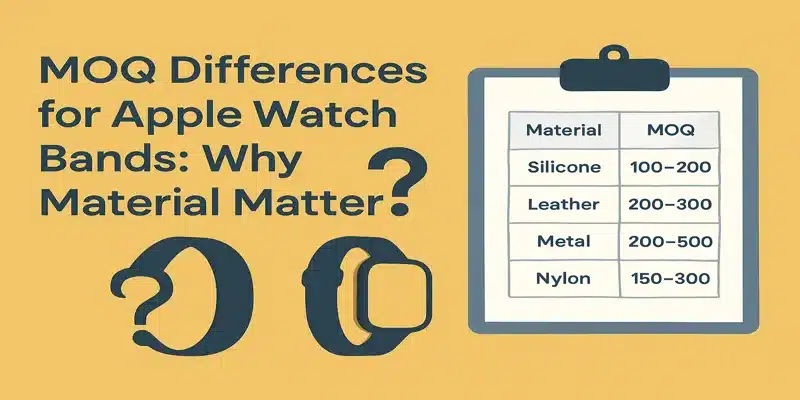
✦ 03| The Challenges of High MOQs—and How to Navigate Them
For small businesses and startups, MOQ often feels like a mountain standing in the way of progress. Let’s break down the real-world challenges buyers face when dealing with high MOQs—and how to approach them strategically.
1. Buyer Challenges: Why High MOQs Are a Pain Point
01 Capital Pressure
A MOQ of 300 or 500 units isn’t just a number—it’s an upfront investment. For a small business, tying up capital in inventory means less cash available for marketing, product development, or operations.
02 Inventory Risk
What if the product doesn’t sell? High MOQs can lead to excess stock, dead inventory, and financial strain—especially when you’re still testing market demand.
03 Market Testing Limitations
You want to try different colors, materials, or designs—but MOQ makes it hard. Ordering 500 units of each option just to test the waters isn’t feasible for most startups.
04 Barrier to Entry
For first-time entrepreneurs, high MOQ feels like an impossible hurdle. It limits experimentation and makes it harder to break into the market.
2. Supplier’s Perspective: Why Small Orders Can Be Problematic
From a supplier’s point of view, small orders often come with disproportionate challenges:
- Higher communication time per unit
- Increased risk of disputes over small details
- Limited room for production errors
- Reduced profitability compared to large orders
👉 It’s not that suppliers don’t want to help small buyers – it’s that the economics are often hard to balance.
Example: A client requested 50 units of a custom-engraved leather band, with a unique color and special packaging. After hours of sampling, material sourcing, and pricing back-and-forth, the deal fell through—because the cost per unit was too high for the buyer, and too low-margin for the supplier.
3. Strategies for Buyers: How to Make MOQ Work for You
Don’t let MOQ stop you—here’s how smart buyers navigate the challenge:
✅ Plan Ahead
Before you approach a supplier, research your market. What styles, materials, and price points are selling? Come with a focused, realistic request—not a “maybe” shopping list.
✅ Start with Standard Products
If you’re on a tight budget, consider beginning with off-the-shelf models. These usually have lower MOQs because they don’t require new molds or complex customization.
✅ Understand Material & Process Differences
Not all bands are created equal—MOQ varies by material and process. For example:
- Silicone = lower MOQ
- Leather = higher MOQ
- Metal = highest MOQ
🔍 Consult our guide: “How Different Materials Affect MOQ.“
✅ Batch Similar Products Together
If you need several styles, try to combine orders for similar materials or designs—this can help you meet MOQ more efficiently.
✅ Be Transparent About Your Plans
Share your long-term vision with suppliers. If they see growth potential, they may be more willing to work with you on smaller initial batches.
✅ Accept Higher Unit Prices
Sometimes, the trade-off for a lower MOQ is a higher per-unit price. Be prepared for this, and budget accordingly.
✅ Ask About Stock or Overstock Items
Some suppliers may have ready-made inventory or leftover stock they’re willing to sell in small quantities.
✅ Consider Group Buying
Collaborate with other small businesses to place a combined order and meet MOQ together.
✅ Negotiate Flexibility
MOQ isn’t always fixed—but you need to be reasonable, build trust, and demonstrate that you’re a serious buyer.
Final Thought for This Section
MOQ is a challenge—but it’s not a dead end. By understanding the supplier’s perspective, planning strategically, and staying flexible, you can turn MOQ into a manageable part of your sourcing strategy—not a roadblock that stops you before you start.
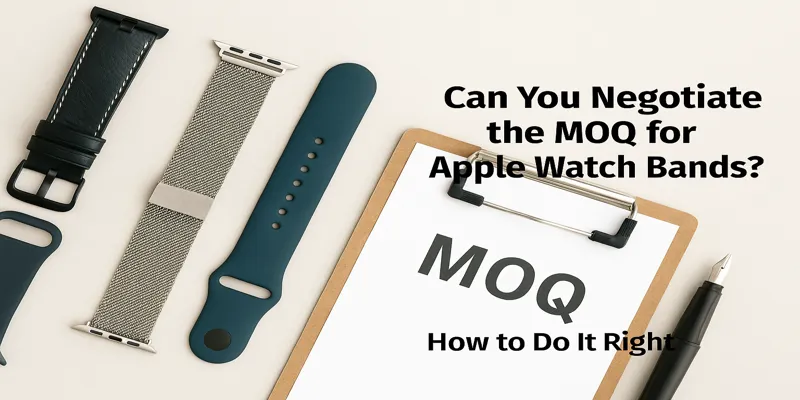
✦ 04|How to Negotiate MOQ with Suppliers: Practical Strategies That Work
Now that you understand why MOQs exist and their often-higher-than-desired threshold, it’s time to shift from passive acceptance to proactive engagement. MOQs are negotiable; the key is mastering the right approach to get suppliers to say “yes.”
1. First, Understand the Supplier’s Position
Before you ask for a lower MOQ, step into the supplier’s shoes:
- They’re not trying to make your life difficult.
- They’re trying to protect their business: covering raw material costs, minimizing waste, and keeping the production line efficient.
Before negotiating, put yourself in the supplier’s shoes: they aim to cover costs, minimize waste, and maintain efficient production. Understanding this gives you an edge in communication.
2. Build Trust First, Then Make Your Request
MOQ negotiations aren’t just about numbers—they’re about relationships.
Here’s how to lay the groundwork:
| Step | Why It Works |
|---|---|
| Communicate openly | Explain why you’re asking for a lower MOQ—market testing, startup phase, etc. |
| Show your long-term vision | Share plans for scaling if things go well. Suppliers love growth stories. |
| Be specific | “I’m looking for 100 units in this color for initial testing, with plans to order 500 per month if successful.” |
| Offer flexibility | Be open to material, packaging, or slight design tweaks to make the order feasible. |
MOQ negotiation is about building relationships. Clearly communicate your needs and future plans, and demonstrate your flexibility and long-term partnership intentions. Suppliers are more likely to make exceptions for those they trust.
3. Smart Negotiation Tactics That Actually Work
- Accept a Fair Premium: Lower MOQs often come with higher unit prices – it’s compensation for the supplier’s added costs.
- Share Upfront Costs: Offering to cover sample or mold fees shows commitment and reduces supplier risk.
- Explore Stock Opportunities: Inquire about existing or overstock items, which often have lower MOQs.
- Propose Flexible Delivery: Suggest partial shipments to ease the supplier’s inventory burden.
- Simplify Customization: Fewer custom elements increase the likelihood of a smaller order.
- Showcase Brand Potential: Use data and vision to earn the supplier’s trust.
- Ask Targeted Questions: Dig deeper into the supplier’s MOQ policies and flexibility.
- Ask the Right QuestionsInstead of just saying “Can you lower the MOQ?”, try:
- “Is there an MOQ difference for existing models versus custom designs?”
- “If I pay for the mold upfront, can we lower the MOQ?”
- “What’s the smallest order you’ve accepted before?”
4. Ready-to-Use Negotiation Scripts
Here’s an example message you can adapt:
Feel free to adapt this example:
Dear [Supplier Name],
I’m very interested in your [Apple Watch band model] and want to test the market initially. Given that we’re a new brand, the 300-unit MOQ is a bit high.
Would you consider a smaller initial order (e.g., 100 units) at a slightly higher per-unit price? We plan to scale orders quickly based on positive market feedback.
We’re happy to discuss covering mold or setup fees if necessary. Looking forward to building a long-term partnership!
Best regards,
[Your Name]
Be professional, clear, and respectful – you’re seeking a collaborative opportunity.
Be professional, clear, and respectful – you’re seeking a collaborative opportunity.
5. What NOT to Do in MOQ Negotiation
✅ Don’t say “Just give me the lowest price.”
✅ Don’t demand unreasonable terms (e.g., 50 units + custom logo + custom packaging).
✅ Don’t ignore the supplier’s perspective.
✅ Don’t act like every supplier owes you a deal.
Remember: Understanding, flexibility, and a commitment to the future are key to winning supplier cooperation. Read our comprehensive guide on packagingl
Final Thought for This Section
MOQ negotiation is about finding a win-win. Treat suppliers as partners, demonstrate your sincerity and long-term vision, and they’ll be more willing to work with you on lower minimums.
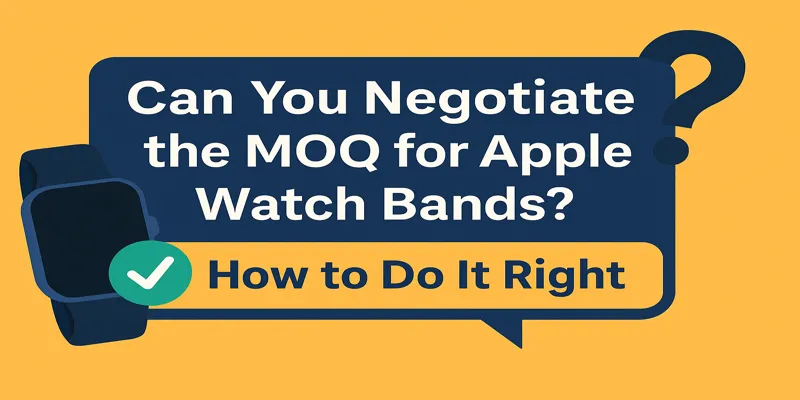
✦ 05|Beyond MOQ: Building Long-Term Success with Your Suppliers
MOQ might be the first challenge you encounter when sourcing Apple Watch bands—but it’s not the whole story. The most successful buyers don’t just negotiate MOQ; they build partnerships.
Let’s talk about what really matters when it comes to long-term success in the Apple Watch band business.
1. It’s Not Just About Price—It’s About Trust
Many new buyers focus solely on price and quantity—but experienced buyers know that’s just the tip of the iceberg. Long-term relationships with suppliers go far beyond the numbers.
✅ What do good suppliers really value in a buyer?
- Clear communication
- Realistic expectations
- Flexibility when problems arise
- Respect for their time and expertise
- Timely payments and consistent orders
Newcomers focus on price and quantity; veterans prioritize trust and long-term value. Deep collaboration with suppliers extends far beyond numerical deals. Excellent suppliers value buyers who communicate clearly, set realistic expectations, adapt flexibly, respect their expertise, and pay promptly. Trust is the passport to future collaboration.
2. How to Be a Buyer That Suppliers Want to Work With
Here’s what sets strong, long-term buyers apart:
- ✅ Transparent Planning, Shared Vision: Share your goals and growth roadmap.
- ✅ Respect the Process, Trust Each Other: Understand production timelines and avoid unnecessary changes.
- ✅ Pay On Time, Keep Your Word: This is crucial for earning better terms.
- ✅ Invest in Relationships, Build Connections: Communicate actively and even visit the factory if possible.
- ✅ Solve Problems Together, Don’t Just Blame: Collaborate on solutions instead of solely pointing fingers.
3. Why Yusslab Supports Small-Batch Buyers
At Yusslab, we understand the challenges small businesses face—because we’ve helped so many brands grow from small-batch orders to large-scale production.
1 We don’t just look at the first order; we look at the potential for long-term collaboration.
2 That’s why we offer flexible MOQ options, support custom designs even in small quantities, and provide honest advice based on our manufacturing experience.
3 We believe every brand has the potential to grow—and we want to be part of your success story.
Final Thought for This Section
MOQ is just a starting point. Strong partnerships are what unlock real opportunities.
When you approach suppliers with trust, respect, and a willingness to collaborate, Treat your suppliers with trust and a collaborative spirit, and even high MOQs can pave the way for long-term mutual wins.
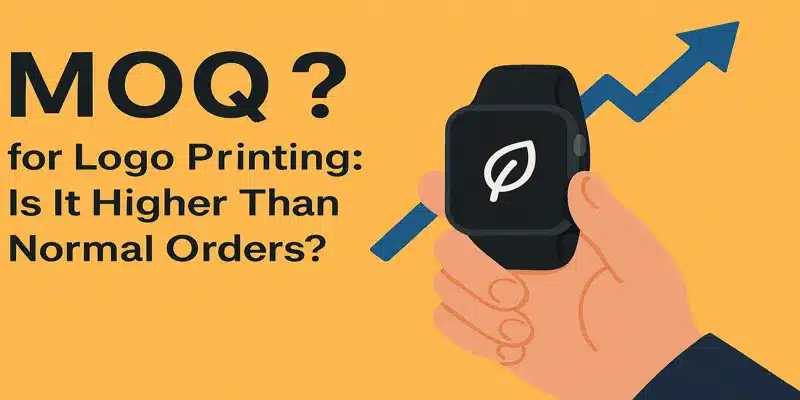
✦ 06|FAQs: Apple Watch Band MOQ Explained
1️⃣ Why is the MOQ for Apple Watch bands so high?
Apple Watch band MOQs aren’t random—they’re based on production efficiency, material sourcing, and risk management. Learn the full story here:
👉 Why Is the MOQ for Apple Watch Bands So High?
2️⃣ Does the material affect the MOQ?
Absolutely. Different materials—like silicone, leather, or metal—require different manufacturing processes, which impact MOQ. Get the breakdown:
👉 How Different Materials Affect MOQ
3️⃣ Is the MOQ higher for custom logos and packaging?
Yes. Customization adds complexity: new molds, setup costs, and quality checks all raise the MOQ. Read more:
👉 MOQ for Logo Printing: Is It Higher Than Standard Orders?
4️⃣ Can I order Apple Watch bands in small batches?
Sometimes—depending on the supplier, model, and stock availability. But there are trade-offs, like higher unit prices and limited customization. Here’s how to approach small orders:
👉 Can Apple Watch Bands Be Ordered in Small Batches?
5️⃣ Can I mix styles or colors to meet the MOQ?
Maybe. Some suppliers allow mixed styles or colors within a total MOQ, but each SKU usually has its own minimum. Get the details:
👉 Can Apple Watch Bands Be Mixed in a Single Order? How Does MOQ Work?
6️⃣ Can I negotiate the MOQ with suppliers?
Yes—but it’s about how you ask. Build trust, show potential, and offer flexibility. Our full guide:
👉 Can You Negotiate the MOQ for Apple Watch Bands?
7️⃣ What’s the best way to start sourcing Apple Watch bands with a limited budget?
Start with in-stock models and focus on standard designs. Build a relationship with your supplier, and as your brand grows, you’ll gain more leverage for customization and better pricing.
8️⃣ Why does MOQ matter for my business?
MOQ affects everything: your inventory risk, upfront capital requirements, and ability to test the market. Understanding MOQ helps you make smarter sourcing decisions.
All You Need to Know About Custom Apple Watch Bands
- Watch Band Packaging Custom Guide
- Apple Watch Bands: Material Selection Guide
- Apple Watch Band Sampling and Lead Time Guide
- Apple Watch Band Logo Customization Guide
- Apple Watch Band Design Trends & Popular StylesGuide
📞 Ready to Get Started?
At Yusslab, we help brands grow by offering flexible MOQ options, expert guidance, and premium Apple Watch bands tailored to your vision. Whether you’re testing the market or scaling up, we’re here to make it happen.
✅ Let’s turn your ideas into reality—contact us today to discuss your project!
